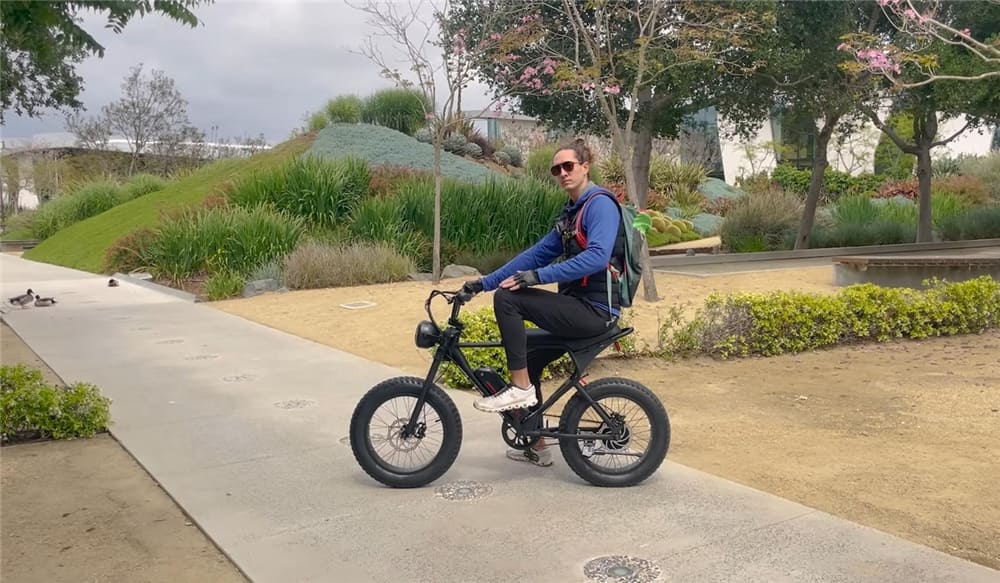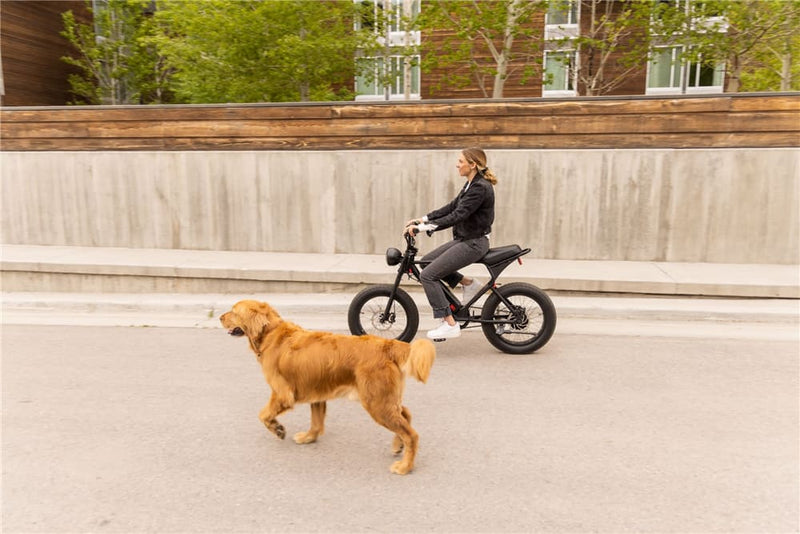The popularity of electric bicycles (commonly known as eBikes) has revolutionized the way we think about commuting and recreational cycling. Especially in a state like Iowa, where the terrain varies, both urban and rural communities have embraced the efficiency and environmental friendliness of these machines. It's not just about rising trends; it's about understanding the dynamics of using them legally and safely. If you're thinking about jumping on the e-bike bandwagon in Iowa, or you're already a proud Macfox ebike owner, it's crucial to delve into the specifics of the state's e-bike laws.
The Definition of eBikes in Iowa
In the heart of the Midwest, Iowa has stepped up its efforts to clearly define what constitutes an eBike. In Iowa's legal context, eBikes are defined as bicycles equipped with a motor that doesn't exceed 750 watts (equivalent to 1 horsepower). This translates into an achievable speed of up to 20 miles per hour on level ground if one is relying solely on the motor's power. This distinction ensures that eBikes aren't mistakenly classified as motorbikes or scooters, which naturally fall under a different set of regulations. This clarity provides eBike owners, potential buyers, and law enforcers with a streamlined understanding, ensuring that there's no ambiguity when it comes to usage and rights on the road.

Classification of eBikes
With technological innovations at the helm, eBikes are not a one-size-fits-all commodity. Iowa recognizes this diversity and classifies eBikes into three main categories for clarity:
-
Class 1 eBikes: A pure blend of manual and motorized cycling, these eBikes are pedal-assist only, devoid of any throttle mechanism. They boast a maximum assisted speed of 20 mph. Predominantly, they are the choice of those who seek a balance between exercising and effortless riding.
-
Class 2 eBikes: Infusing a bit more autonomy into the eBiking experience, these bikes can reach a max speed of 20 mph, and uniquely, they can operate via a throttle, even if the rider chooses not to pedal. They're for those who occasionally wish to take a break from pedaling but keep moving.
-
Class 3 eBikes: These are the epitome of speed in the eBike realm. Exclusively pedal-assist, they lack a throttle but can attain an impressive top speed of 28 mph. Suitable for those who desire a faster commute while ensuring they get a good dose of exercise.
Where Can You Ride eBikes in Iowa?
Iowa’s diverse landscape offers multiple avenues for eBikers.
On Roads: The state generously permits all classes of eBikes on its roads, mirroring the privileges of traditional bicycles. However, as with all vehicles, adhering to specific rules and regulations is non-negotiable.
Bike Paths & Multi-Use Paths: These pathways, often the lifeline of many commuting cyclists and recreational users, are accessible to Class 1 and Class 2 eBikes unless there's a specific local ordinance that says otherwise. This makes the daily commute or leisurely rides seamless.
Trails & Mountain Bike Paths: Nature enthusiasts, take note! Before venturing onto trails or mountain bike paths, a quick check of local regulations is a must. Some trails might be welcoming to Class 1 eBikes but could be restrictive for other classes. This step ensures the conservation of these natural paths and the safety of all users.
Related Reading: What Wattage Is Best For E-Bikes?
Safety Requirements & Equipment
As the popularity of eBikes continues to surge in Iowa, the state emphasizes the paramount importance of safety. Riding an eBike, like any other vehicle, comes with its own set of responsibilities.
Helmets: A quintessential gear for safety, Iowa mandates that riders under the age of 18 wear helmets when navigating an eBike. This rule ensures the protection of the young riders, given their vulnerability. While adults have the discretion to choose, wearing a helmet is always a wise and recommended decision.
Lights: Illumination, particularly during dusk, dawn, or nighttime, is critical. Iowa’s law stipulates that all eBikes must come fitted with a white front light, powerful enough to be visible from a distance of at least 300 feet. Similarly, the rear should either have a red reflector or a light that can be spotted from 300 feet when used between sunset and sunrise. This dual light system not only ensures the rider's visibility but also aids in identifying potential obstructions in their path.
Bell or Horn: In the bustling roads of Iowa or even on serene trails, the need to signal your presence can arise unexpectedly. Hence, each eBike in Iowa should possess a functioning bell or horn, not as a decorative accessory, but as an alert mechanism for other road users. However, it's crucial to remember that sirens or whistles are not sanctioned as suitable alternatives.
Age Restrictions for eBike Riders
Age considerations play a vital role in ensuring the safety of eBike riders and those around them. In Iowa, there’s a distinct demarcation: for operating a Class 3 eBike, a rider needs to be at least 16 years old. This restriction acknowledges the slightly more sophisticated nature of these bikes and their speed. For Class 1 and Class 2 eBikes, there isn’t a stringent age limit. However, riders below 16 should always be under the watchful supervision of an adult. This harmonious blend of freedom and oversight guarantees that young riders can enjoy their eBike experience without compromising on safety.
Parking Your eBike
Parking, though often overlooked, is an integral part of the eBike experience. In Iowa, eBikes should be parked responsibly, ensuring they don't become impediments to pedestrian traffic. The guiding principle should always be to ensure safety and prevent any possible hazards. Wherever available, designated bike racks or parking zones should be the preferred choice, offering both security and convenience.
Insurance and Registration
For many potential eBike owners, the administrative aspect of ownership can seem daunting. However, Iowa offers a respite in this regard. eBikes in the state are exempt from the typically cumbersome processes of registration, insurance, or licensing. Nevertheless, proactive owners should always confer with their insurance providers to explore possible coverage options, especially focusing on accidental damage or theft.
Local Ordinances
Statewide regulations indeed provide a broad framework for eBike usage. However, the granularity of local city or county ordinances cannot be ignored. They might contain specific nuances or additional restrictions concerning eBikes. Staying updated with these local rules ensures riders are always in compliance and can enjoy a hassle-free eBike experience.

Conclusion
The beauty of Iowa e-bikes lies not only in their efficiency, but also in the complex rules that ensure their safe and enjoyable use. By internalizing and complying with Iowa e-bike laws, every enthusiast, whether resident or visitor, can enjoy the state’s unparalleled ebike experience.
FAQs
Q1: Are there specific trails in Iowa where only Class 1 eBikes are allowed?
Yes, some trails in Iowa might be exclusive to Class 1 eBikes. It's always advisable to check local regulations before venturing out.
Q2: If I'm an adult, is it mandatory for me to wear a helmet while riding an eBike in Iowa?
While it's mandated for riders under 18, adults have the discretion to choose. However, wearing a helmet is always recommended for safety.
Q3: In the absence of mandatory registration, how can I safeguard my eBike against theft in Iowa?
While registration isn't obligatory, getting your eBike insured and always parking in designated or secure areas can act as a safeguard against potential theft.
We recommend for you:
- Exploring the Benefits of Macfox Electric Bikes for Urban Living
- Searching for the Most Effective Commuter Ebike
- Empowering Your Commute: The Ultimate Guide to Commuter eBikes
- The Environmental Benefits of Owning an Electric Bike | How Macfox Helps Reduce Carbon Emissions
- The Longest Range eBike: Your Comprehensive Guide


















